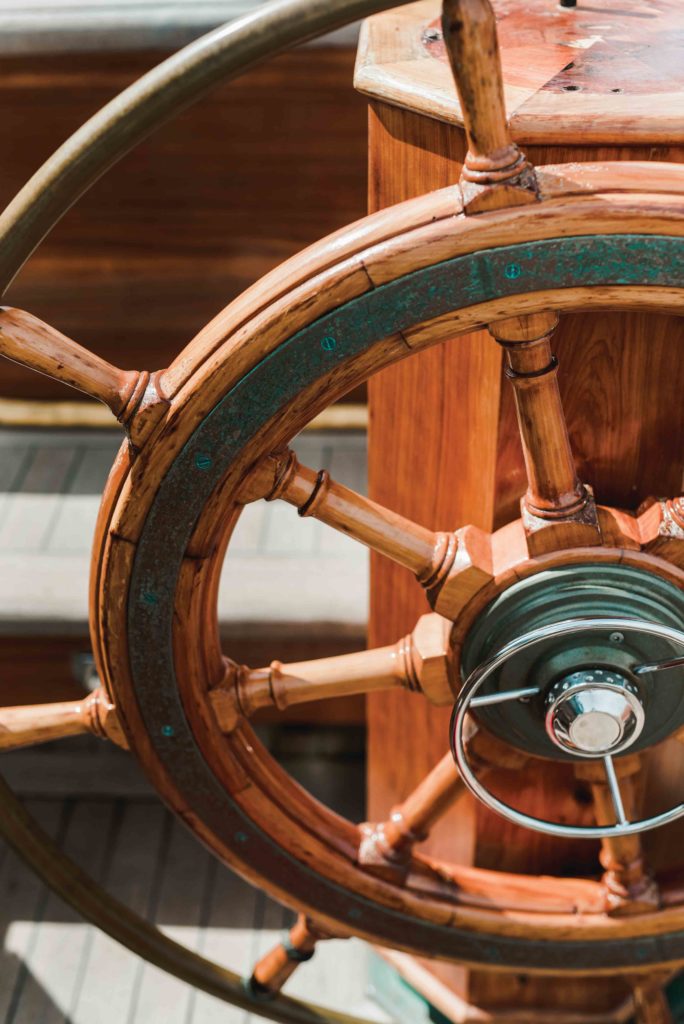By Her Bootstraps
On tall ships and research vessels all over the world, and at boatyards on the Maine coast, Hannah Gray gets the job done

Hannah Gray has two days to oversee the completion of an engine rebuild on the Spirit of Bermuda in Belfast Harbor. She’s racing to get the iconic 112-foot sloop-of-war replica, built 14 years ago by Rockport Marine, ready to head home to Bermuda before the hurricane window closes so students there can continue learning to sail on her. “Boats, God love them, are just always more involved and costly than you think,” says Gray. She has fabricated equipment for scientists tagging whales in Antarctica, guided a boat lowering a research robot into a West Coast deep-sea canyon, and faced pirates in the Gulf of Aden, and she always returns home to Belfast to await the next challenge.
Gray isn’t a trained marine engineer, but she always gets the job done. She’s a one-woman show who has become an integral thread in the tight-knit fabric of boatbuilders and mariners in Maine and well beyond.The five-foot-six laser-focused bootstrapper started off in a one-room schoolhouse on Great Cranberry Island, which has a year-round population of 40. She was the only student in her grade, from kindergarten through eighth grade, and four of the fewer than two dozen other students were her siblings. Her dad owned the local boatyard. She became a teenage deckhand and, in college, found a way back out to sea on a research vessel in Chile. She graduated and worked in New York City’s nonprofit sector for a few years until she begged her dad’s friend to let her solo sail his single-mast Friendship sloop, a design once used for lobster boats, up and down the Maine coast. “It was tiny, like 25 feet, and I was in way over my head,” says Gray. “At the end of the day I would barely get the anchor down, open a can of something that wasn’t even heated up, and just fall asleep. But I was really into the challenge.”
She sailed the boat to Great Cranberry Island and was prepared to return to New York when a call came in, an offer “so obvious it was right” that she never looked back. The owner of the daysailer Gray had worked on in high school sent her on the wildest adventure of her 24 years. As first mate on a 43-foot ketch, she and a crew of four sailed down the eastern seaboard, through the Caribbean to the Panama Canal, across the Pacific Ocean, to Fiji then Australia, through Indonesia and Thailand, and into the Red Sea and the Mediterranean, landing in Italy.
It was a purposeful way for Gray to see the world, not as a tourist but as someone looking for common ground, whether with an outboard mechanic or a local selling grease. “I really don’t like feeling like an outsider, I think because living in Maine is about authenticity,” she says. The trip got exceedingly dangerous in the Gulf of Aden, where Somalia and Yemen are separated by less than 100 miles. It was a few years after 9/11, and looking for safety in numbers, the crew sailed toward Djibouti in a diamond-shaped convoy of seven. The group included a glamorous sailboat (and a captain who knew it) and a “charming but frustrating” Dutch couple who slept on their sloop through the night, and constant disregard from most of the convoy for the no-radio-chatter rule. Things didn’t get easier.

Bermudian school kids will take the wheel when the engine is rebuilt. 
The crew lowers the boom before the sloop sets sail. 
Gray manages the engine rebuild for the ship, which was built by Rockport Marine 14 years ago.
The winds died, forcing the convoy to motor for a couple of days, then in came an alert about a pirate attack on a cargo ship in the trackline ahead. They were warned to avoid it by 50 miles, but that would have put them too close to the volatile coast of Yemen. At dawn, the seven boats in the convoy approached the waypoint of the pirate sighting. “We start to see this wooden skiff with an outboard that you associate with both fishermen and pirates in that area,” says Gray. “At that exact moment, the engine of one of the boats in our convoy craps out.”
“We couldn’t leave them, so we turned around,” she says. The convoy circled around the broken boat, and the wooden skiff drew closer. Then, one by one, identical skiffs with their sails up cropped up on the horizon, and before they knew it ten wooden skiffs had formed a large outer ring around their boats. “They were just watching us, and we were just watching them, and nobody was saying anything,” she says. This went on for five hours, as the crew worked on dead-calm seas in eerie silence to get the boat running again. When they finally fixed it, they sailed on without a fight. “We’ll never know who they really were,” says Gray.

She arrived safe back in Maine, and the experience made her more determined than ever to tackle bigger, more complicated boats, and to complete the last Atlantic leg of her circumnavigation. This time she joined a tall ship crew taking 100 college students around the transatlantic slave-trade triangle—up to Canada, over to England, and down to Portugal and nearby islands—before docking in Sierra Leone on an excursion with barely enough food and water. After that ill-advised trip, Gray sailed on other tall ships—one to the Caribbean with the since-closed Maine nonprofit Ocean Classroom Foundation, another across the Great Lakes.
By age 34, she had spent a total of about seven years at sea—enough to qualify her to teach at Maine Maritime Academy (MMA). “I told students humility is important. You better question yourself, because chances are that the consequences of assuming you know something will quickly catch up with you on the boat,” says Gray, who’s reserved until you get her going: “All eyes are on you, and the only way you’re going to get the practice is if you do it while everyone’s watching, even though it might not go well.” MMA later hired Gray to rebuild the hull and systems of its 88-foot-long schooner Bowdoin, which is the official vessel of Maine. “[Franklin] Roosevelt would mention the boat in his fireside chats, and it was the first to do a lot of radio work over the North Pole,” Gray says. Hodgdon Brothers (now Hodgdon Yachts) in East Boothbay built the ship in 1921 under the direction of Admiral Donald MacMillan, who designed its double-planked, double-framed wine glass–shaped hull to navigate dangerous Arctic waters. Gray became the first mate on one trip around Newfoundland.
These days, you’ll find Gray in Boothbay shepherding one of the last surviving Gloucester fishing schooners, the Ernestina-Morrissey, through the final phases of a rebuild. Throughout all of her navigation, ship handling, and rebuilds, more times than not, she’s been the only woman on board. “I’ve noticed that women don’t always like doing something unless they feel confident it’s going to be a success, and I’m always fighting that impulse in myself,” says Gray. “If I dock a boat, someone might clap for me and say, ‘That’s amazing,’ when they probably wouldn’t say anything if it were a man.” Other than a culture of low expectations, Gray hasn’t noticed any other barrier due to her gender. That’s what happens when you prove you can do anything on a boat anywhere. Now, she’s dreaming up her next passage. “I’m currently obsessed with barges,” she says, “so I’m going to look at a barge today. I love the idea of having a marine construction business.”

